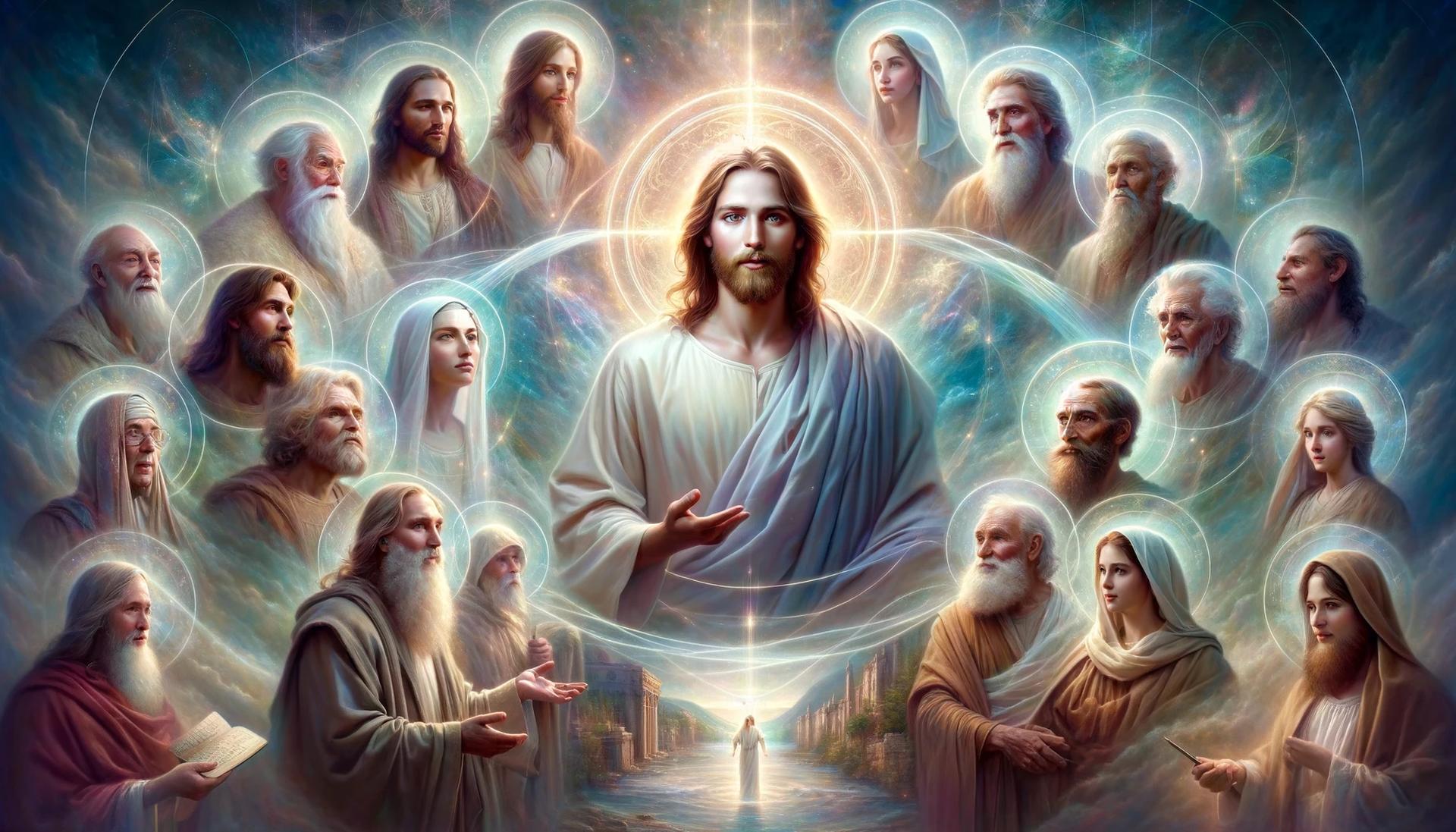Home>Christian Videos>Bible Stories>What Skin Color Is Jesus Christ


Bible Stories
What Skin Color Is Jesus Christ
Published: March 2, 2024
Peter Smith, Editorial Director at Christian.net, combines deep insights into faith, politics, and culture to lead content creation that resonates widely. Awarded for his contributions to religious discourse, he previously headed a major organization for religious communicators, enhancing dialogue on faith's societal impacts.
Discover the truth about Jesus Christ's skin color in the Bible stories. Uncover the historical and cultural context of his portrayal.
(Many of the links in this article redirect to a specific reviewed product. Your purchase of these products through affiliate links helps to generate commission for Christian.net, at no extra cost. Learn more)
Table of Contents
The Historical Context of Jesus Christ's Skin Color
The historical context of Jesus Christ's skin color is a topic of much debate and speculation. Many scholars and historians believe that Jesus, as a Jewish man living in the Middle East during the 1st century, would have likely had a darker complexion. The region where Jesus lived was known for its warm climate and abundant sunshine, which would have contributed to a darker skin tone for the inhabitants. Additionally, the Bible describes Jesus as being a descendant of King David, who was also believed to have had a ruddy or darker complexion. These historical and geographical factors point to the likelihood that Jesus Christ had a skin color that was darker than what is commonly depicted in Western art and culture.
-
Geographical and Historical Factors: The geographical location of Jesus's life and ministry in the Middle East, as well as the historical context of the time, provide important insights into the likely skin color of Jesus Christ. The region's climate and the ethnic makeup of the population at that time would have influenced Jesus's physical appearance.
-
Cultural and Ethnic Identity: Understanding the cultural and ethnic identity of Jesus Christ within the context of ancient Judea and the Jewish people is crucial in considering his skin color. Jesus was born into a Jewish family and was a part of the Jewish community, which has implications for his likely physical appearance.
-
Historical Artifacts and References: While there are no direct historical artifacts or references that definitively describe Jesus's physical appearance, studying the historical context and available evidence can provide valuable insights into the skin color of Jesus Christ.
-
Scholarly Research and Analysis: Scholars and researchers have delved into historical records, archaeological findings, and biblical texts to gain a deeper understanding of Jesus's likely skin color. Their findings contribute to the ongoing discussion about the historical context of Jesus Christ's physical appearance.
Understanding the historical context of Jesus Christ's skin color requires a comprehensive examination of the geographical, cultural, and historical factors that shaped his identity and appearance. This exploration provides valuable insights into the diverse and multifaceted nature of Jesus's life and legacy.
Read more: What Was Jesus Christ’s Profession
Depictions of Jesus Christ in Art and Culture
The depictions of Jesus Christ in art and culture have varied widely throughout history and across different regions of the world. In Western art, Jesus has often been portrayed with fair skin, light brown hair, and blue eyes, reflecting the cultural norms and artistic conventions of the time. These representations have been influenced by the prevailing standards of beauty and the idealization of European features. However, as Christianity spread to diverse global regions, the depictions of Jesus began to reflect the ethnic and cultural characteristics of the local populations. In African, Asian, and Latin American art, Jesus has been depicted with features that align more closely with the local ethnicities, challenging the traditional Western portrayal of a Caucasian Christ. This diversity of artistic representations underscores the impact of cultural perspectives and artistic interpretations on the portrayal of Jesus Christ's physical appearance.
-
Evolution of Artistic Representations: Over the centuries, the artistic representations of Jesus Christ have evolved in response to cultural, social, and religious influences. From the early Christian catacomb art to the Renaissance masterpieces and contemporary interpretations, the depictions of Jesus have reflected the artistic styles and prevailing cultural norms of their respective eras.
-
Cultural and Regional Variances: The depictions of Jesus Christ in art and culture vary significantly across different regions and ethnic groups. In Ethiopia, for example, Jesus is often depicted with darker skin and distinctively Ethiopian features, reflecting the country's rich Christian heritage and cultural identity. Similarly, in India, Jesus has been portrayed with features that resonate with the Indian population, emphasizing the diverse and inclusive nature of his universal message.
-
Symbolism and Interpretation: The portrayal of Jesus Christ in art and culture often carries symbolic and interpretive significance. Artists have used their creative expressions to convey theological, social, and political messages through their depictions of Jesus. Whether as a symbol of compassion, suffering, or divine majesty, the artistic representations of Jesus reflect the multifaceted nature of his role in religious and cultural narratives.
-
Challenges to Traditional Depictions: In recent years, there has been a growing awareness of the need to challenge traditional depictions of Jesus Christ and to embrace a more inclusive and diverse representation. This has led to artistic movements and initiatives aimed at reimagining Jesus in ways that reflect the global diversity of humanity, acknowledging the cultural and ethnic richness of the Christian faith.
The depictions of Jesus Christ in art and culture serve as a testament to the dynamic interplay between religious beliefs, artistic expression, and cultural diversity. These representations not only reflect the evolving interpretations of Jesus' physical appearance but also offer insights into the complex relationship between faith, identity, and artistic creativity.
Theological Perspectives on Jesus Christ's Physical Appearance
The theological perspectives on Jesus Christ's physical appearance encompass a range of interpretations and theological considerations within the Christian faith. While the Bible does not provide a detailed physical description of Jesus, theological reflections on his appearance have been shaped by doctrinal, cultural, and historical factors. Some theological perspectives emphasize the divine nature of Jesus Christ, transcending physical attributes and emphasizing his spiritual significance. This view underscores the belief that Jesus' physical appearance is secondary to his role as the Son of God and the savior of humanity. Additionally, theological discussions often highlight the universal and inclusive nature of Jesus' message, emphasizing that his identity transcends specific physical characteristics and resonates with people of diverse ethnicities and backgrounds. Furthermore, theological perspectives on Jesus' physical appearance intersect with broader theological themes, such as the incarnation, the humanity of Christ, and the cultural contextualization of Christian faith. These perspectives contribute to a rich theological discourse that acknowledges the profound spiritual impact of Jesus Christ while recognizing the diverse cultural and historical interpretations of his physical form.
-
Divine Nature and Spiritual Significance: The theological perspectives on Jesus Christ's physical appearance often emphasize his divine nature and spiritual significance, highlighting the transcendent nature of his identity. This theological approach underscores the belief that Jesus' physical appearance is secondary to his role as the Son of God and the savior of humanity.
-
Universal Message and Inclusivity: Within theological discussions, there is an emphasis on the universal message of Jesus Christ, which transcends specific physical attributes and resonates with people of diverse ethnicities and backgrounds. This perspective underscores the inclusive nature of Jesus' message, inviting people from all walks of life to embrace his teachings and experience spiritual transformation.
-
The Incarnation and Humanity of Christ: The theological perspectives on Jesus' physical appearance intersect with the doctrine of the incarnation, which affirms the belief that Jesus, as the Son of God, took on human form. This theological concept underscores the humanity of Christ, acknowledging his physical embodiment while also affirming his divine nature.
-
Cultural Contextualization of Christian Faith: The theological perspectives on Jesus' physical appearance are influenced by the cultural contextualization of Christian faith. As Christianity spread to diverse global regions, the interpretations of Jesus' physical form became intertwined with the cultural expressions and artistic representations of the local populations, enriching the theological discourse with diverse perspectives.
The theological perspectives on Jesus Christ's physical appearance reflect the multifaceted nature of Christian theology, encompassing doctrinal, cultural, and historical dimensions. These perspectives contribute to a deeper understanding of the spiritual significance of Jesus Christ while acknowledging the diverse interpretations of his physical form within the rich tapestry of global Christianity.
The Impact of Jesus Christ's Skin Color on Modern Society
The impact of Jesus Christ's skin color on modern society extends into various aspects of contemporary culture, identity, and social discourse. The portrayal of Jesus as having a specific skin color has significant implications for how individuals perceive their own racial and ethnic identities, as well as how they relate to others within a diverse and multicultural society. Additionally, the representation of Jesus' skin color influences artistic expressions, theological interpretations, and discussions surrounding inclusivity and diversity within religious communities. Moreover, the historical and ongoing debates about Jesus' skin color have sparked critical reflections on the intersection of race, religion, and power dynamics, prompting conversations about representation, privilege, and social justice. As modern society grapples with issues of racial equality and cultural diversity, the impact of Jesus Christ's skin color serves as a catalyst for deeper introspection and dialogue on the complexities of identity, representation, and the pursuit of a more inclusive and equitable world.
-
Cultural Identity and Representation: The portrayal of Jesus Christ's skin color in art, media, and popular culture influences how individuals perceive their own cultural identities and how they are represented within broader societal narratives. The depiction of Jesus as having a specific skin color can shape the self-image and cultural pride of diverse communities, highlighting the significance of representation in shaping collective identity and fostering a sense of belonging.
-
Theological Interpretations and Diversity: Within religious communities, the portrayal of Jesus Christ's skin color has prompted theological discussions about the diversity of human experiences and the universal message of spiritual inclusion. The recognition of Jesus' potential non-European appearance challenges traditional Eurocentric interpretations of Christianity, fostering a more inclusive understanding of the faith and its relevance to people of diverse racial and ethnic backgrounds.
-
Social Justice and Equity: The ongoing debates about Jesus Christ's skin color have contributed to broader conversations about social justice, equity, and the dismantling of racial hierarchies. The recognition of Jesus as a figure who transcends specific racial categories has prompted critical reflections on the implications of racialized representations and the need for greater inclusivity and representation within religious and cultural spheres.
-
Artistic Expression and Creativity: The portrayal of Jesus Christ's skin color has inspired artists to explore diverse representations of the religious figure, challenging traditional artistic conventions and offering new perspectives on the intersection of faith, identity, and creativity. This artistic exploration serves as a means of celebrating cultural diversity and reimagining religious iconography in ways that resonate with contemporary global realities.
The impact of Jesus Christ's skin color on modern society underscores the complex interplay between religion, culture, and identity, prompting critical reflections on representation, diversity, and the pursuit of a more inclusive and equitable world. As society continues to navigate issues of race, representation, and social justice, the portrayal of Jesus' skin color serves as a catalyst for meaningful dialogue and transformative action toward a more inclusive and empathetic global community.















